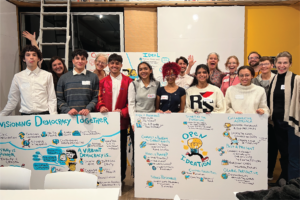Writing Across the Curriculum With The Literacy Design Collaborative

The Literacy Design Collaborative is a network of teachers and partners “building out a template-based approach to the literacy demands of college and the workplace, as defined by the Common Core State Standards.” The concept is to give teachers tools (mostly offline but soon to be online) that enable them to transform the Common Core into classroom action by giving teacher the literacy resources to build student’s college ready literacy skills through their existing content lens.
Chad Vignola, most recently of New Visions for Public Schools, recently took over as Executive Director with the charge of making LDC a sustainable enterprise.
The LDC has roots in Vicki Phillips experience as a local and state superintendent in Pennsylvania. The guidebook to LDC, written by Marilyn Crawford, Stacy Galiatsos, Anne C. Lewis, explains that the LDC “allows teachers to build content on top of a coherent approach to literacy.”
LDC is not a lesson plan library, it’s a framework that helps teachers across the curriculum promote standards-based literacy. The LDC approach starts with a task, usually a writing prompt, that asks secondary students to take on an important issue (and the complex texts that students must wrestle with to be college ready.) Tasks can be rolled up into modules. A complete module will include examples of quality student work. A group of modules roll up to a course.
Here is an example of a social studies teaching task:
How did the political views of the signers of the Constitution impact the American political system? After reading Founding Brothers: The Revolutionary Generation, write a report that addresses the question and support your position with evidence from the text.
But that’s just the start to the tools the LDC framework supplies to enact the Common Core in their classrooms. There are ‘default’ ladders of instruction that include skill clusters and literacy subskill definitions to help teachers plan lessons.
LDC is a ‘task-central’ approach to helping students demonstrate Common Core expectations. Other LDC design principles include:
- Distributes responsibility for reading and writing,
- Connects reading and writing instruction,
- Fosters a responsive system, and
- Encourages local choice and is teacher-friendly.
Task templates encourage assignments that asks students to:
- Think in ways that prepare students for success in college and the workplace,
- Read, analyze, and comprehend texts as specified by the common core,
- Write products as specified by the Common Core, and
- Apply Common Core literacy standards to content (ELA, social studies, and/or science)
“The ‘pre-fab’ template tasks are intended to respect teachers content knowledge while scaffolding their practice to in turn scaffold student skill acquisition”, said Vignola.
Templates include scoring rubrics that support consistent assessment across the curriculum. This is a great approach to enlisting more writing across the curriculum. It would have been useful at the elite private school I visited last week where students did lots of writing but there was no consistent approach to assessment. Good schools have a common intellectual mission–one that demands writing across the curriculum–and it just makes sense to use a common approach to creating tasks and assessing work.
About 25 states have begun using the LDC with three planning full integration–Louisiana, California, and Kentucky. The National Writing Project supports this effort to make make standards practical.
Online tools–albeit rudimentary–to support collaboration and knowledge sharing exists on the LDC website and more are in the pipeline. Useful tools like Edmodo and the Teaching Channel already provide opportunities for teachers to collaborate on Common Core using LDC and other rigorous approaches to making Common Core support our student’s success.
If you don’t want a scripted approach to writing but want students writing more and better, check out the Literacy Design Collaborative.
Edmodo is a portfolio company of Learn Capital, where Tom is a partner.
This blog is brought to you by The Nellie Mae Education Foundation as part of a series on blended humanities. For more stayed tuned for the Getting Smart on Blending Middle Grade Humanities bundle and see the other posts in this series:





Annabelle Howard
Thanks for this. I just posted it on my G+ Community: Common Core Conversation. Perhaps you'd like to join?
https://plus.google.com/communities/109527785867200831030/stream/a70e2c42-8660-4b16-9280-df5e8c9ae901
Another community I started might also interest you: CommonCorePLAYS
https://plus.google.com/communities/114482145111484452906
Annabelle
Big FUN Education (non profit)